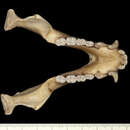Biology
provided by Arkive
Despite being widespread, De Brazza's monkey is generally shy and inconspicuous, only rarely announcing its presence with deep, booming group calls (1) (5). This species is mostly arboreal, but unlike other guenons, which usually stay in the tree canopy, it is often found moving through the forest understory or along the ground (6). The diet consists mainly of fruits and seeds, although leaves, mushrooms and small reptiles and insects may also be consumed (4) (5). As foraging usually takes place in exposed areas, food is stored in cheek pouches, and only eaten when the monkeys return to a safe location (4).
Throughout much of its range, this species lives in polygynous groups of between eight and ten individuals, but in certain regions, such as Gabon, De Brazza's monkeys can be found in small, monogamous family groups, comprising a male-female pair and their offspring (2) (6). Interestingly, De Brazza's monkey is the only guenon species that forms these strong breeding pair bonds (5). Although groups maintain small territories that they mark out with saliva and scent, they do not appear to show any aggression towards other groups of De Brazza's monkey that enter these areas (4) (5). In contrast, when encroachment is made by a different species of monkey, De Brazza's monkeys may become extremely hostile, with the entire group becoming involved in forcibly ejecting the intruder (4).
De Brazza's monkey breeds throughout the year, with the female usually giving birth to a single infant after a gestation period of around 168 to 187 days. In order to reduce the risk of predation, the vulnerable infant clings tightly to the mother's stomach. Weaning takes place after around one year, but the young begin to try solid food after about two months of age. De Brazza's monkeys become sexually mature at around age five or six, and may live for up to 22 years in the wild (4).
De Brazza's monkey is preyed upon by numerous animals, such as large African eagles, leopards, and other primates—including humans (7). When a group is threatened, the females and the young generally hide in the undergrowth, while the male climbs a tree and makes loud calls in an attempt to distract the predator (6).
Conservation
provided by Arkive
De Brazza's monkey occurs in a number of protected areas across its range, thereby safeguarding, to some extent, against habitat loss (1). The recent discovery of this species in the Lesio-Louna and south-west Lefini Reserves in the Democratic Republic of Congo, has shown that conservation activities targeted towards reintroducing gorillas to the region have also helped the local De Brazza's monkey population to recover from years of heavy hunting (8).
De Brazza's monkey is listed on Appendix II of the Convention on International Trade in Endangered Species (CITES), and therefore any international trade is strictly controlled through maximum export quotas (3). In addition, in many African countries, hunting of this species requires authorisation (1) (9), while in Ethiopia it is prohibited altogether (7). Despite these controls, the bushmeat trade for De Brazza's monkey—along with many other species—continues to grow (4). In order to combat this, a consortium of conservation organisations called the Bushmeat Crisis Task Force has been established. By working with governments, organisations and the general public, they aim to eliminate unsustainable and illegal bushmeat hunting practices worldwide (10).
Description
provided by Arkive
De Brazza's monkey is one of the most distinctive species of guenon, a collective name for members of a large group of African monkeys belonging to the genus Cercopithecus (4). The head is adorned with a striking orange-red crescent shaped patch on the brow, and the face has a white muzzle extending into a long, white beard. The coat is mostly finely speckled grey and white, with black limbs and tail. Other distinguishing features include a white thigh stripe and rump and, in the male, a bright blue scrotum (2) (4).
Habitat
provided by Arkive
De Brazza's monkey generally occupies forested regions close to rivers and waterways, including dense swamp forest, lowland tropical forest, and mountain forest up to elevations of 2,200 metres (1) (2).
Range
provided by Arkive
One of the most widespread guenon species, the range of De Brazza's monkey extends from Cameroon, southwards, through northern Gabon, and Congo to northern Angola, and eastwards through much of the Democratic Republic of Congo and southern Central African Republic to eastern Uganda. Fragmented populations are also found in western Ethiopia, extreme southern Sudan and eastern Kenya (1).
Status
provided by Arkive
Classified as Least Concern (LC) on the IUCN Red List (1) and listed on Appendix II of CITES (3).
Threats
provided by Arkive
Although De Brazza's monkey is widespread, it is never found in abundance in any part of its range, and in many regions appears to be undergoing a decline. The main threat to this species is habitat loss due to ongoing forest clearance for agriculture and timber (1). In addition, De Brazza's monkey is also hunted for food, and may become increasingly targeted due to the expansion of the bushmeat trade (1) (4).

